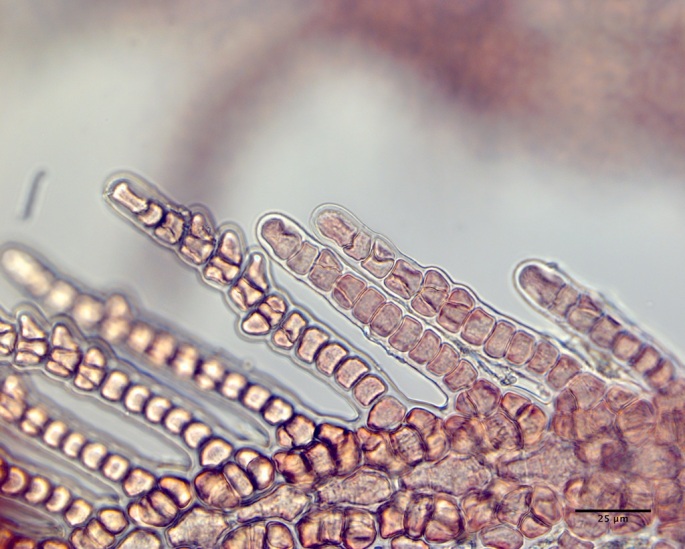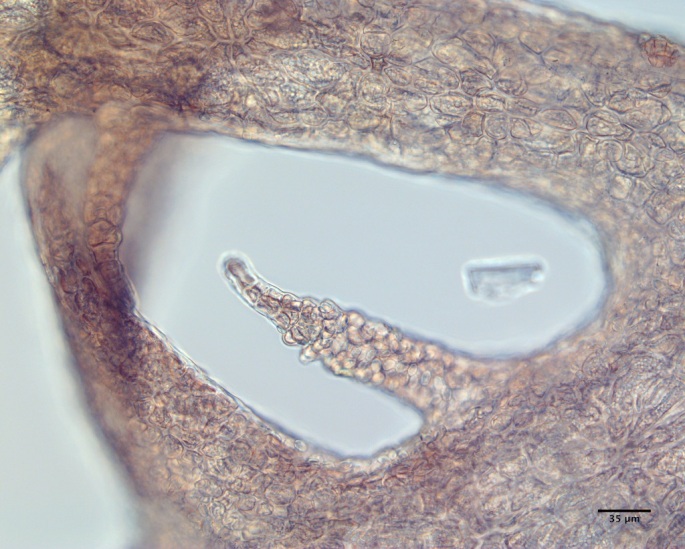Thalli pinkish to dark red in colour with pinnate opposite leading and lagging branches that alternate along the axes to give distinctive thalli that typically range from 5-30 cm in height (Image A). Thalli are fairly rigid and generally maintain their shape when removed from water. Cortical cells cover the entire thallus, except for the apical 1-2 cells (Image B), however, in our Canadian isolates (not observed in or Norwegian collections), there was also delayed cortication in ultimate branches resulting in distal and proximal monosiphonous portions (Image C). The lagging branch in each pair of branches typically (but not exclusively) has a spine-like appearance (Image D).
To the inexperienced collector confusion with Plumaria plumosa (Hudson) Kuntze is a possibility, but that species has delicate and flaccid thalli that collapse when removed from water, as well as sparse cortication in ultimate branches and extended monosiphonous tips (monosiphonous portions can be distal and proximal in ultimate branches of our Canadian Ptilota gunneri). A critical distinction is the regular alternation of leading and lagging branches in Ptilota spp. versus the alternating series of 2-3 in Plumaria plumosa (Hudson) Kuntze. More problematic is Ptilota serrata Kützing, which is widely distributed in the Arctic and NW Atlantic. In the last mentioned species the lagging branch in each pair typically acquires a claw-like rather than spine-like appearance (Image D). The occurrence of distinctly monosiphonous proximal portions in some ultimate branches of Ptilota gunneri appears distinct to this species in our Canadian collections (Image C). Given the rarity of Ptilota gunneri in our flora, collections are most likely Ptilota serrata Kützing – DNA data are necessary where an absolute identification is required.
Rare in our flora, in colder waters with a genetically verified record from the subtidal (20m) in Bonne Bay, NL, as well as one drift collection each from Cable Head, PE, and Churchill, MB. The “Featured image” above is actually a collection from Norway (GWS040620).
 Image A. Specimen from Hellesøy, Norway, displaying the typical habit of this species (GWS040013).
Image A. Specimen from Hellesøy, Norway, displaying the typical habit of this species (GWS040013).
 Image B. Typical apical cell with cortication to the tip in a rehydrated specimen from Bonne Bay, NL (GWS007247).
Image B. Typical apical cell with cortication to the tip in a rehydrated specimen from Bonne Bay, NL (GWS007247).
 Image C. Delayed cortication resulting in distal and proximal monosiphonous regions in ultimate branches (Churchill, MB; GWS005434).
Image C. Delayed cortication resulting in distal and proximal monosiphonous regions in ultimate branches (Churchill, MB; GWS005434).
 Image D. Spine-like habit of a lagging branch (GWS007247).
Image D. Spine-like habit of a lagging branch (GWS007247).
